Related Research Articles

Dinghy sailing is the activity of sailing small boats by using five essential controls:
The Mirror is a type of popular sailing dinghy with more than 70,000 built.

Dinghy racing is a competitive sport using dinghies, which are small boats which may be rowboats, have an outboard motor, or be sailing dinghies. Dinghy racing has affected aspects of the modern sailing dinghy, including hull design, sail materials and sailplan, and techniques such as planing and trapezing.
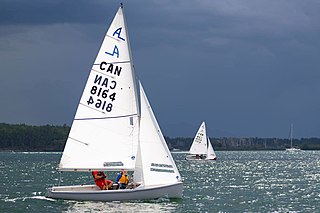
The Albacore is a 4.57 m (15 ft) two-person planing dinghy, for competitive racing and lake and near-inshore day sailing. Hulls are made of either wood or fiberglass. The basic shape was developed in 1954 from an Uffa Fox design, the Swordfish. Recent boats retain the same classic dimensions, and use modern materials and modern control systems.

The GP14 is a popular sailing dinghy, with well over 14,000 built.

The Laser is a class of single-handed, one-design sailing dinghies using a common hull design with three interchangeable rigs of different sail areas, appropriate to a given combination of wind strength and crew weight. Bruce Kirby designed the Laser in 1970 with an emphasis on simplicity and performance.

The National 12 is a two-person, two-sail, twelve-foot long sailing dinghy. They are sailed extensively in the UK. The class was started in 1936 by the Royal Yachting Association as an alternative to the more expensive International 14s.

The Wayfarer is a wooden or fibreglass hulled fractional Bermuda rigged sailing dinghy of great versatility; used for short 'day boat' trips, longer cruises and for racing. Over 11,000 have been produced as of 2016.

The 470 (Four-Seventy) is a double-handed monohull planing dinghy with a centreboard, Bermuda rig, and centre sheeting. Equipped with a spinnaker, trapeze and a large sail-area-to-weight ratio, it is designed to plane easily, and good teamwork is necessary to sail it well. The name comes from the boat's length of 470 centimetres.
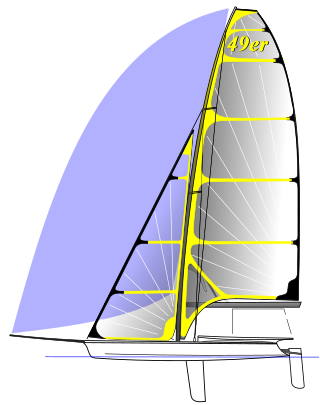
The 49er and 49er FX is a two-handed skiff-type high-performance sailing dinghy. The two crew work on different roles with the helm making many tactical decisions, as well as steering, and the crew doing most of the sail control. Both of the crew are equipped with their own trapeze and sailing is done while cantilevered over the water to the fullest extent to balance against the sails.
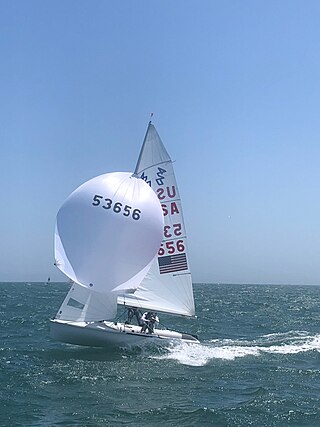
The International 420 Dinghy is a sailing dinghy popular for racing and teaching. The hull is fiberglass with internal buoyancy tanks. The 420 has a bermuda rig, spinnaker and trapeze. It has a large sail-area-to-weight ratio, and is designed to plane easily. The 420 is an International class recognised by World Sailing. The name refers to the boat's length of 420 centimetres.
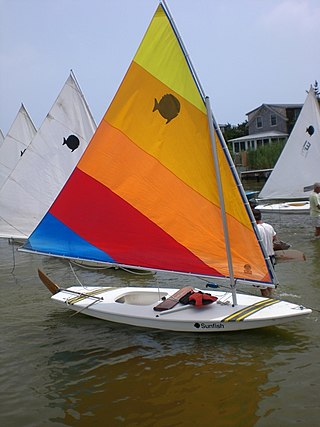
The Sunfish is a personal-size, beach-launched sailing dinghy. It features a very flat, boardlike hull carrying an Oceanic lateen sail mounted to an un-stayed mast.

The Fireball is a British sailing dinghy that was designed by Peter Milne as a one-design racer and first built in 1962.
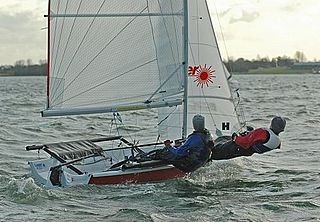
The Laser 4000 is a racing dinghy designed by Phil Morrison crewed by two persons. Its one-design weight-equalised system enables physically differing sailors to compete on a level playing field. It is most popular in Europe, particularly the UK, France and Italy.

The International 14 is a British racing sailboat, crewed by two sailors. The class was established in 1928.

The Moth is a small development class of sailing dinghy. Originally a small, fast home-built sailing boat designed to plane, since 2000 it has become an expensive and largely commercially produced boat designed to hydroplane on foils though many are still built at home, typically at much lower cost.

The C Scow is an American sailing dinghy that was designed by John O. Johnson as a one-design racer and first built as early as 1905. Sources disagree as to the first-built date, with claims of 1905, 1906 and 1923.
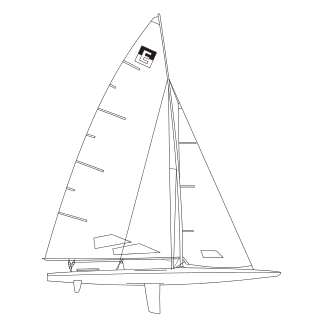
The E Scow is an American sailing dinghy that was designed by Arnold Meyer Sr as a one-design racer and first built in 1924.

The National Solo class is a racing dinghy designed by Jack Holt in 1956. The Solo is sailed in the United Kingdom, Holland, Portugal and Australia.

The RS Tera is a one-man monohull dinghy in the RS Sailing range of sailing boats. It is recognised by the International Sailing Federation (ISAF) as an international class, and is a popular boat for beginners and for children to race.
References
- ↑ "Portsmouth Number List 2012". Royal Yachting Association. Retrieved 31 July 2012.